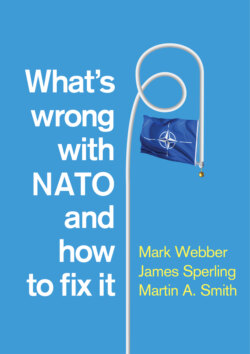Читать книгу What's Wrong with NATO and How to Fix it - Mark Webber - Страница 30
Thin Commitment
ОглавлениеNATO’s orientation to new tasks has been driven by the need to demonstrate relevance. The Alliance has, however, struggled to add substance to some of its high-level political commitments. Counter-terrorism (CT) policy provides a good example. On the one hand, NATO can point to some concrete progress following its mission reorientation after 9/11. Many of the relevant measures have already been noted, but it is worth emphasizing that NATO’s two longest missions – ISAF/Resolute Support in Afghanistan and Operation Active Endeavour/Sea Guardian in the Mediterranean (launched in October 2001 and ongoing as of 2020) – have their origins in CT action. NATO has also been busy creating institutional capacity (a Terrorism Intelligence Cell was set up in 2017), agreeing CT Policy Guidelines and action plans for the allies (first adopted in 2012), embedding CT training in partnership programmes and exchanging expert knowledge with allies and partners through the Science for Peace Programme, the Emerging Security Challenges Division and the work of the Centre of Excellence for Defence against Terrorism based in Ankara. In mid-2017, NATO became a formal partner in the Global Coalition to Defeat ISIS. But despite these efforts, the Alliance has fared poorly in coordinating its actions with those of other bodies, notably the EU. It also lacks many of the tools essential to CT efforts: it has no ability to apply sanctions, block terrorist funding, police the borders of its members or liaise with national civil authorities dedicated to homeland security. NATO, in contrast to the EU, also still lacks its own CT Coordinator.74
NATO’s CT efforts have become increasingly associated with its Projecting Stability agenda, working with partners ‘to build stronger defence institutions, improve good governance, enhance […] resilience and […] more effectively contribute to the fight against terrorism’.75 Projecting Stability has been favourably compared to NATO’s eastern strategy of the 1990s, where a similar ‘preoccupation with the shape of an entire geopolitical system’ gave rise to a sense of strategic priority.76 But the differences are also clear. PfP, the Alliance’s signature partnership policy of the 1990s, was geared toward eventual NATO membership for many of its participants. Such is not the case with NATO partnership schemes focused on the MENA region. The influence that a membership perspective can bring to bear on local military and political transformation has thus been absent. The problems in the MENA region are also on a scale greater than the post-communist east. Most states of the region are characterized by ‘challenging demographic developments, […] a stagnant economy, illegal migration, violent forms of political Islam’ and the negative effects of climate change (involving water shortages and crop failures).77 COVID-19 has only exacerbated these problems.78 Further, MENA is home to powerful non-state actors (Hezbollah, ISIS and groups representing the Kurdish populations of Turkey, Syria and Iraq), regional rivalries and proxy competition. Iran, Russia, Turkey, Saudi Arabia, Israel and the US have all, in various permutations, competed for influence, so exacerbating violence in Iraq, Yemen, Libya and Syria. Within these very difficult circumstances, NATO’s positive influence has been limited. Its defence reform and capacity-building programmes have been beneficial to a handful of countries in the Persian Gulf and North Africa (Jordan and Tunisia, for instance). The Alliance has also adopted a partnership ‘Package for the South’ (endorsed at the NATO summit of July 2018) and stood up a Strategic Direction-South Hub in Naples and a Regional Centre in Kuwait. But overall, as a NATO Parliamentary Assembly report concluded in 2018, the Alliance’s efforts have proven ‘insufficient to address the multifaceted threats emanating from its Southern flank’.79
NATO’s standing in the region has also not been helped by the legacy of its intervention in Libya in 2011. (That mission overthrew Qaddafi but did not stick around to help with the transition to a new political order. Libya has been in a state of civil unrest ever since.) But lurking behind this is a much bigger issue of purpose. NATO’s Military Committee has drawn up a Military Concept for Projecting Stability, but, according to Jeffrey Larsen, still lacks ‘a strategy that articulate[s] clearly [the Alliance’s] ultimate goals, as well as adequate funding and the political support of member states’.80 NATO is internally divided over what to do in MENA and cooperates poorly with organizations such as the UN and the EU that are better suited to operating there. Following the draining experience of Afghanistan, and wary of the pitfalls of Syria and Iraq, many allies have simply preferred to keep NATO out of the region. The Alliance has thus become victim to its own raised expectations: claiming an important role in the region but lacking the appetite to do much of any significance. NATO is, in institutional terms, too ‘thin’. It lacks the capacity to address the problems it has identified and has suffered a loss of credibility as a result.81
